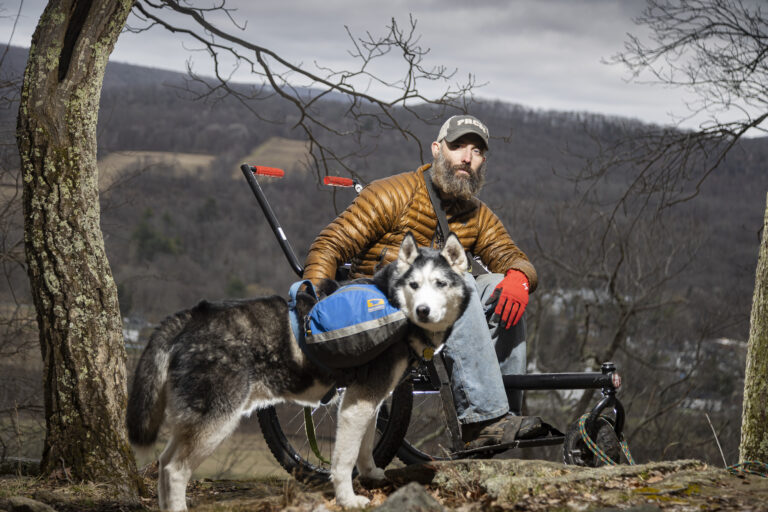
Photo by Christopher Beauchamp
The concept behind wheelchair mushing is simple: You train a dog, or group of dogs, to reliably follow commands, then put harnesses on them, attach them by pull lines to your wheelchair and let them run. Mushing isn’t a free ride, though. Moving at speed is physical for both human and dog. Add obstacles, like other dogs, people, small creatures, brush and weather changes, all requiring quick adjustments, and you have a sport challenging enough to satisfy committed thrill-seekers.
Three wheelchair users who regularly mush — Rodney Higgins, Don Wheeler and Jared Fenstermacher — have their own unique approaches to the sport, but they share a common message: Wheelchair dog mushing is a hell of a lot of fun.
Figuring It Out
Six years after being diagnosed with Transverse Myelitis, Rodney Higgins was still struggling with the transition to life as a wheelchair user. “I was an outdoor person. While I always had a desk job, I spent my free time in my yard — pruning, planting, landscaping. I spent vacations camping and hiking. Now, suddenly, I was an indoor person,” Higgins says. “I lost my connection with nature. It was almost like being deficient in a vital mineral in your diet. Alive, but not really healthy.”
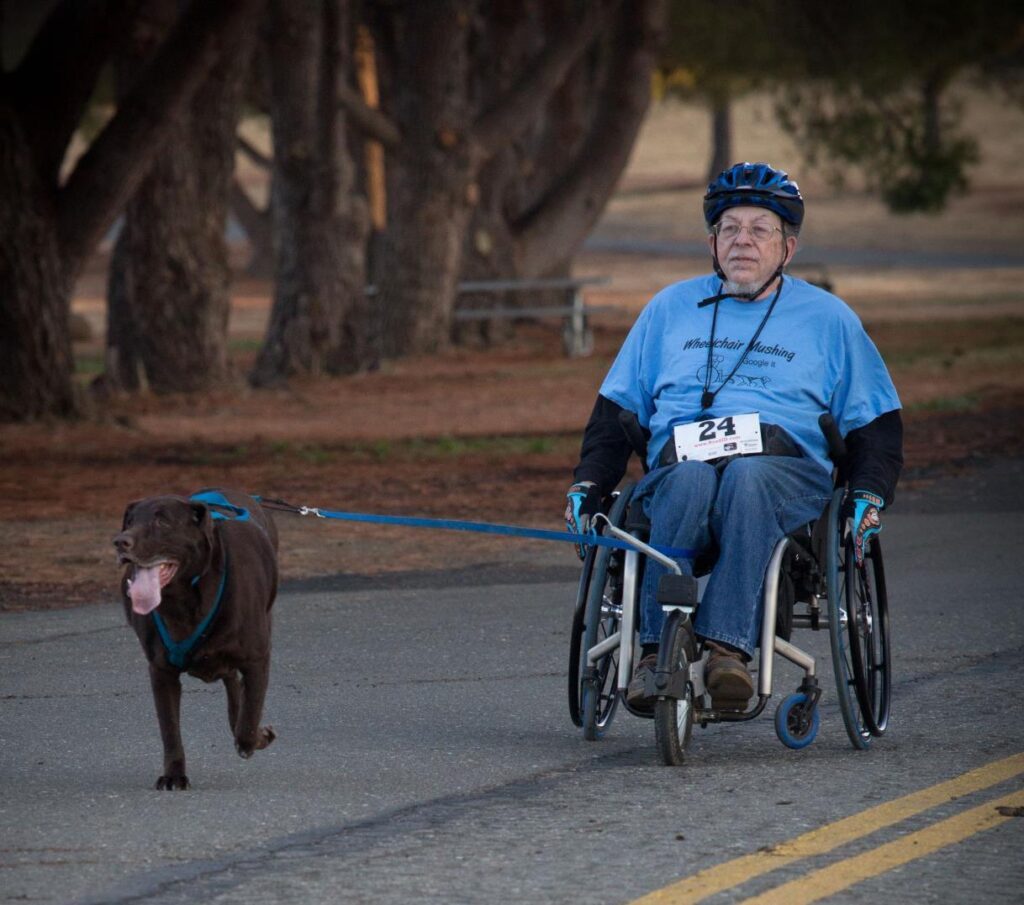
Everything changed in 2011 when he decided to train his Labrador retriever, Skyler Rose Raindancer (Sky), to pull him in his wheelchair. Starting on the sidewalks near his home in Woodland, California, Rodney and Sky mushed 30 minutes every day for the first month. Later they moved to the greenbelt multipurpose pathways of nearby Davis and regularly mushed 3-4 miles a visit. “Discovering the long rural pathways in Davis was more than a ‘wow’ moment. The natural setting reconnected me with nature and was a big part of my mental healing,” he says.
Eight years later and 2,500 miles away, in Cleveland, Ohio, Don Wheeler had a similar experience. Pre-injury, Wheeler owned huskies and long dreamed of one day racing a dog sled team. In 2004 he had a motorcycle accident, sustaining an incomplete spinal cord injury at C6-7. It took him more than a decade to build up his confidence to try mushing as a wheelchair user. In 2019 he joined the Siberian Husky Club of Greater Cleveland for educational purposes and then adopted a 3-year-old husky named Dash. “Mushing with Dash was the closest thing I had felt to riding a motorcycle again. I was hooked,” says Wheeler, who shares his mushing adventures on his Team Dash YouTube channel.
The promise of getting to spend time with dogs and going fast was more than enough to attract Jared Fenstermacher to wheelchair mushing. An avid dog lover and endurance athlete prior to being paralyzed in 2016, Fenstermacher, now a T5 incomplete para, fell hard for his new passion. “Wheelchair mushing has been a natural fit,” he says. “Wheelchair mushing benefits the dogs but also gives me a great workout since mushing requires both balance and arm strength.”
Fenstermacher runs his husky, Titan, alongside his neighbors’ huskies, Maya and Haze, on the streets around his home in Bloomsburg, Pennsylvania. He shares his adventures on social media to show wheelchair mushing’s potential as a novel way to be more physically active and benefit your pets.
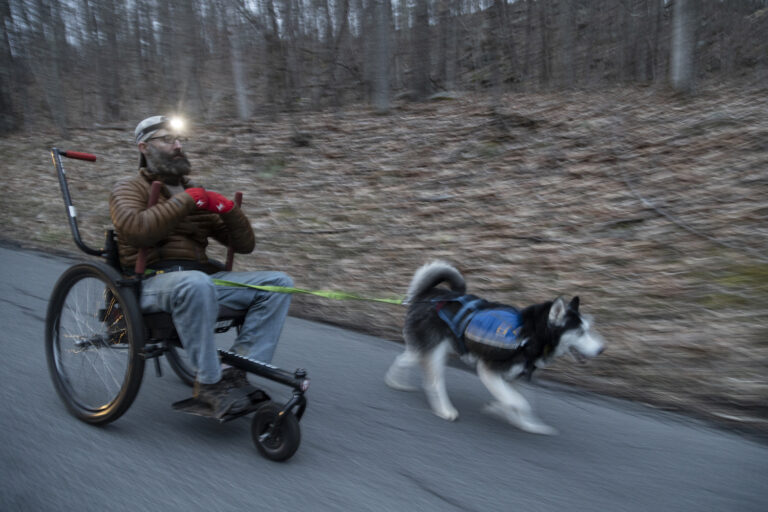
Photo by Christopher Beauchamp
Jared Fenstermacher and his husky, Titan, have hit 15 mph on hard surfaces.
Dog Training
When it comes to wheelchair mushing, it all starts with the dogs. You need a dog capable of pulling you, both physically and temperamentally. Huskies and malamutes are the best-known sled dogs, but other working breeds, including shepherds, heelers and Labradors, have been bred to work and follow commands. Higgins, Wheeler and Fenstermacher all had experience with dog training prior to mushing.
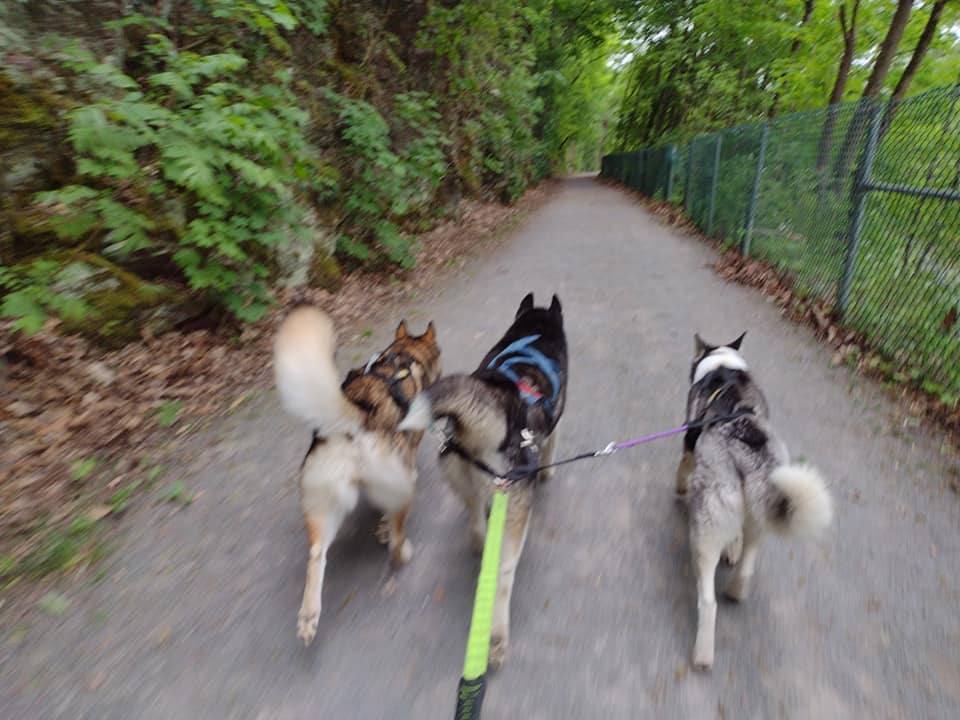
Fenstermacher’s dog, Titan, is both his service dog and mushing partner, performing functional tasks like assisting pulls on carpeted areas. Wheeler’s dog, Dash, is also a service dog trained to support him during low blood pressure episodes. Higgins’ dog, Sky, was a family dog with whom Higgins did basic dog training before teaching her how to mush.
The first training step is teaching the dogs to consistently follow verbal commands. Wheeler says that he always starts training in the backyard, “until I’m confident they can consistently follow commands.”
There are about 10 commands to master (see sidebar) before the dog is ready for a harness. Higgins says there are only three difficult things to teach: No smelling, no meet and greet and no chasing wildlife. “If you can teach your dog those three things, the commands and everything else is easy,” he says.
Mushing Commands
The traditional mushing commands are:
Hike: Get moving.
Gee: Turn to the right.
Haw: Turn to the left.
Easy: Slow down.
Straight Ahead: Keep going straight.
Whoa: Stop.
On By: Keep moving past another team or distraction like other animals on the trail.
Line Out: This is a command to the lead dog to tighten the gangline and pull the team out straight.
While traditional mushing commands are perfectly acceptable, Rodney, Jared and Don favor using their own commands such as:
Walk On: Start and go straight.
Go Go Go or Let’s Go: Go.
Stop: Stop.
Easy: Slow down.
On the road: Transition from sidewalk to road.
Stay: Don’t move.
Go left: Move left.
Go right: Move right.
Sit: Sit.
The dogs’ motivation to learn is usually high, so Higgins advises against using treats for training. “The chance to run is reward enough for the dogs,” he says. “Also, you will need hand-use to control the wheelchair, so I always recommend people avoid bringing treats.”
Fenstermacher agrees. He runs with his own dogs and with other local huskies and they are always excited to run. “You can’t push a dog with a rope,” he says. “The dog pulls on his own accord because he likes adventure and exercise.”
Gearing Up
If you’ve ever been out on a stroll and had a squirrel run across your path, you might think you have everything you need to get pulled around by your dog. But animal safety is key, and a few pieces of specialized equipment can make things safer and more enjoyable for everyone. “I’ve met plenty of people who think they are mushing using a collar and leash,” says Wheeler. “This actually can hurt the animals due to speed and abrupt start-and-stop aspects.”
A properly fitted dog-harness is essential. All three men recommend Alpine Outfitters. They offer a quality harness in a variety of styles and sizes at reasonable prices of $26-$57. Other essentials include ganglines (think a reinforced leash or towline), gloves, hookups to the wheelchair frame or a waist belt, couplers as needed and, if desired, some type of last-resort control option such as a vibration collar. Each system is customized for the owner, dog and the type of surface being mushed on.
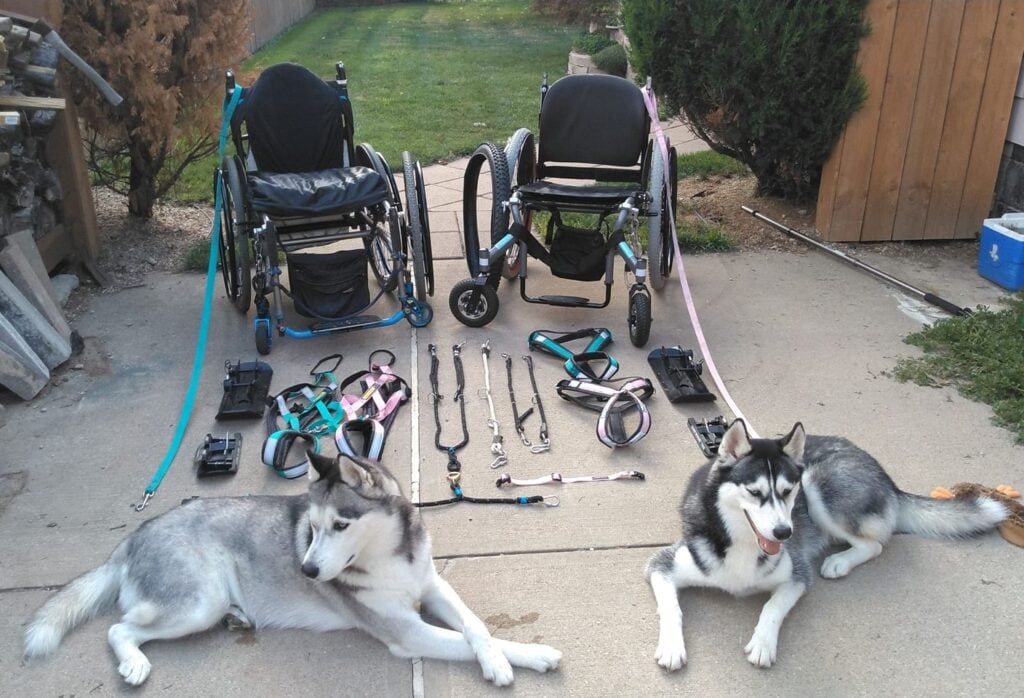
Higgins and Fenstermacher use a FreeWheel to aid speed and control and avoid their front casters digging into bumps, cracks or stray pine cones. Even so, Fenstermacher still takes his fair share of spills. Mushing up to three dogs at a time, he knows his pursuit of speed comes with elevated chances of crashing. “Maya has high prey drive and has pulled me over to the side. It’s not too bad, but I usually get scraped up,” he says.
For Higgins, who mushes with a single dog at slower speeds, the longer wheelbase offered by the FreeWheel makes his chair very stable. “I’ve only crashed three times in 10 years,” he says. “Knowing I had the ability to get back on my chair after a crash gave me confidence. Otherwise, I may have never tried.”
Wheeler rolls without a FreeWheel because of compatibility issues, but has only fallen once. “It wasn’t the dogs’ fault. It was my poor choice of terrain,” he says.
Hitting the Trail
Contrary to many perceptions of mushing, you don’t need a snowy wonderland to get out and about. Higgins prefers to mush on multipurpose paved pathways, particularly in natural settings. He likes the safety of being separated from traffic and the chance to be out in nature. Fenstermacher lives in town and would have to drive with the dogs to reach trails or pedestrian pathways. “Transporting them in the truck is a pain, so I typically use the streets,” he says.
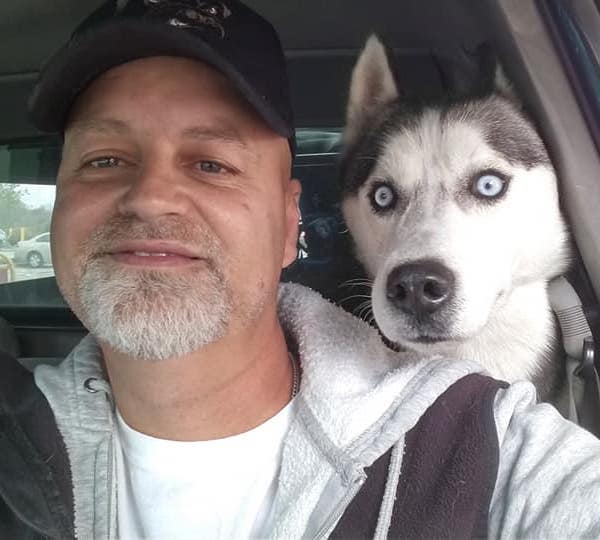
Wheeler favors off-road bike trails or other natural paths, but he also mushes on the streets around his neighborhood. If you’re going to mush on unpaved surfaces, larger knobby tires on your rear wheels help with float and traction. In the winter, Wheeler sometimes mushes in the snow, using attachable skis so his front casters don’t dig in and flip him forward.
In addition to more open space and not having to deal with traffic, off-street mushing offers another perk: fewer people. Fenstermacher says he has to go out mushing with a confident mindset because he’ll often get unsolicited critiques from strangers like, “Are you sure that’s not too much for him?” or, “Isn’t it too cold — or hot or wet or late — to be doing that?”
“I’m stubborn and I refuse to let my disability or others’ opinions of my limitations stop me from doing the things I can and want to do,” he says. “My advice to those wanting to try mushing is to get stubborn, set your mind to it and do your thing.”
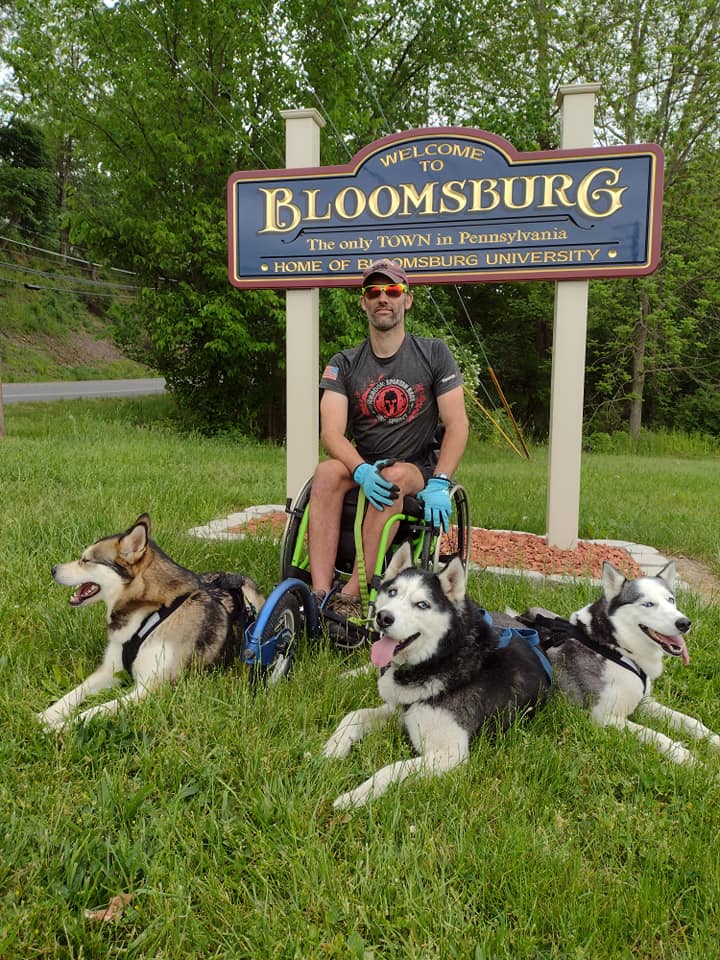
Like everything else, where to go really depends on your goals and what you have around you. Wheeler likes to go long distances — his longest run is 9 miles — and long, uninterrupted paths are ideal. Fenstermacher often mushes at higher speeds — his fastest mile is under 4 minutes — so for him it’s worth putting up with some traffic and ignorant comments to have plenty of space to move.
For now, Fenstermacher looks forward to mushing in the cooler months. “The husky breed particularly needs a lot of exercise, so in mushing season I try to take other local husky dogs out,” he says. “Someday I’d love to mush every street of Bloomsburg, rotating dogs as I go.”
All three men recommend starting slowly and gradually upping distance, just like a human runner would do. Wheeler has been training his two dogs, Gabby and Dash, to work together as a team and slowly improve their fitness levels. His goal is to do a 20-mile continuous run.
Since losing his longtime mushing partner, Sky, Higgins and his wife are dedicating their time to raising an adopted shelter dog named Jackson. “I’ll need to give Jackson more time and training before deciding whether to try wheelchair mushing,” he says. “It doesn’t work for every dog, but when it does, it’s magical.”
Support New MobilityWait! Before you wander off to other parts of the internet, please consider supporting New Mobility. For more than three decades, New Mobility has published groundbreaking content for active wheelchair users. We share practical advice from wheelchair users across the country, review life-changing technology and demand equity in healthcare, travel and all facets of life. But none of this is cheap, easy or profitable. Your support helps us give wheelchair users the resources to build a fulfilling life. |


You guys are AWESOME! As are your pups. I’ve been following Don Wheeler for a while now. Totally impressed with Don and what’s he’s been doing and now with you guys too.
keep on Keeping Mushing ♿️
Thank you TeamDash
I know Don personally and I think it’s great what he is doing. And the other 2 keep it up. Your awsome too. ❤
WOW! I’m so impressed! I’ve been a walker/rollator user since 2013. I have a Freedom Chair from Grit, which I love. The most fun I’ve had was in my old hilly neighborhood. It was very hard work getting up the hills, but then the downhill-oh man! Worth the agony of getting to the top. Thanks for showing us what is possible. Mush on, guys!
here’s another more versatle and safer way- dog powered mobility fun- freedom for the dog to gooo and pull under excellent steering and dog control- urban mushing perfected- d o g p o w e r e d s c o o t e r . c o m